
What is the fraction of each of the shaded parts?
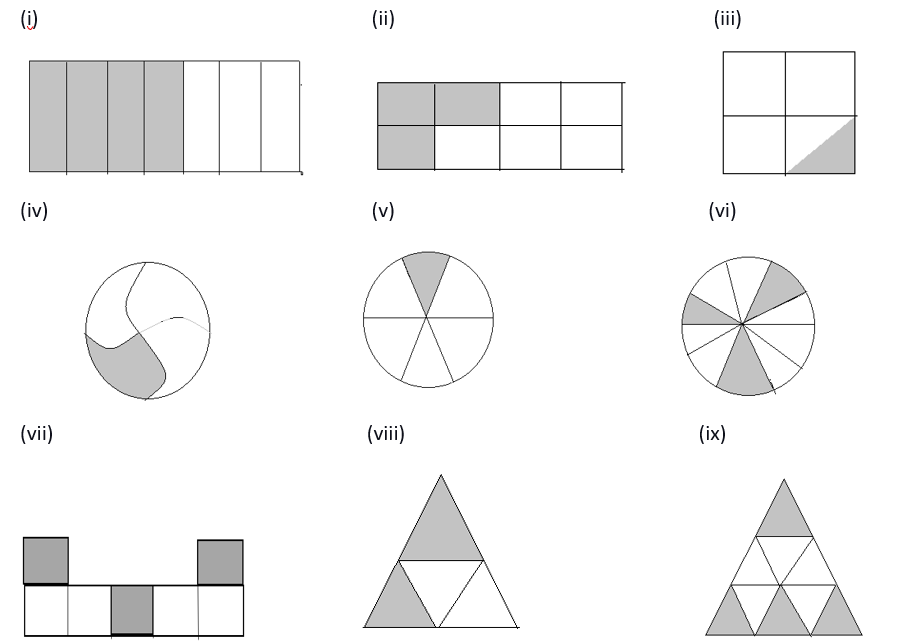

Answer
433.5k+ views
Hint: We need to find the fraction of each of the shaded parts. We start to solve the question by finding out the number of shaded portions and the total number of portions of each figure. Then, the ratio of the number of shaded portions to the total number of portions to get the desired result.
Complete step-by-step solution:
We are given a few figures and are asked to find the fraction of each of the shaded parts. We will be solving the given question by finding out the ratio of the number of shaded portions to the total number of portions.
A fraction, in mathematics, represents a part of a whole thing. It consists of two parts namely,
numerator, denominator.
The number on the top is called the numerator.
The number on the bottom is called the denominator.
Let us understand the concept of the fraction with an example as follows,
Example:
In the above fraction,
According to the question,
We need to find the fraction of each of the shaded parts.
(i)
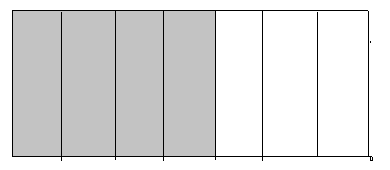
In the above figure,
The total number of portions is equal to 7.
The number of shaded portions is equal to 4.
The fraction of each of the shaded parts is given as follows,
Substituting the values, we get,
(ii)
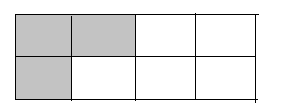
In the above figure,
The total number of portions is equal to 8.
The number of shaded portions is equal to 3.
The fraction of each of the shaded parts is given as follows,
Substituting the values, we get,
(iii)
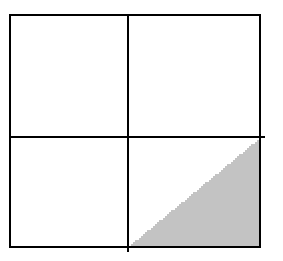
In the above figure,
The total number of triangles formed in the above figure is 8. So, the total number of portions is equal to 8.
The number of shaded portions is equal to 1.
The fraction of each of the shaded parts is given as follows,
Substituting the values, we get,
(iv)
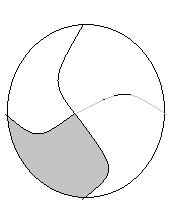
In the above figure,
The total number of portions is equal to 4.
The number of shaded portions is equal to 1.
The fraction of each of the shaded parts is given as follows,
Substituting the values, we get,
(v)
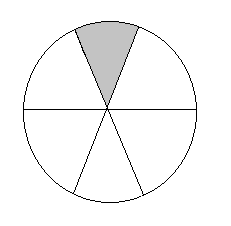
In the above figure,
The total number of portions is equal to 6.
The number of shaded portions is equal to 1.
The fraction of each of the shaded parts is given as follows,
Substituting the values, we get,
(vi)
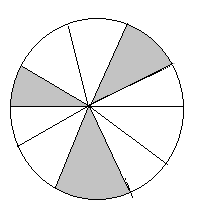
In the above figure,
The total number of portions is equal to 10.
The number of shaded portions is equal to 3.
The fraction of each of the shaded parts is given as follows,
Substituting the values, we get,
(vii)
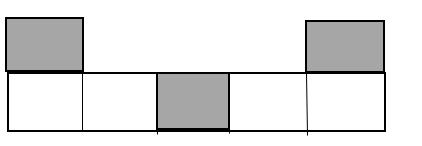
In the above figure,
The total number of portions is equal to 7.
The number of shaded portions is equal to 3.
The fraction of each of the shaded parts is given as follows,
Substituting the values, we get,
(viii)
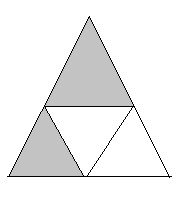
In the above figure,
The total number of portions is equal to 4.
The number of shaded portions is equal to 2.
The fraction of each of the shaded parts is given as follows,
Substituting the values, we get,
(ix)
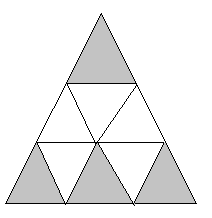
In the above figure,
The total number of portions is equal to 9.
The number of shaded portions is equal to 4.
The fraction of each of the shaded parts is given as follows,
Substituting the values, we get,
Note: The given question is a direct formula based and any mistake in writing the formula to find the fraction of each shaded part will result in an incorrect solution. We must be careful while counting the total number of portions and the number of shaded portions in the figure to get precise results.
Complete step-by-step solution:
We are given a few figures and are asked to find the fraction of each of the shaded parts. We will be solving the given question by finding out the ratio of the number of shaded portions to the total number of portions.
A fraction, in mathematics, represents a part of a whole thing. It consists of two parts namely,
numerator, denominator.
The number on the top is called the numerator.
The number on the bottom is called the denominator.
Let us understand the concept of the fraction with an example as follows,
Example:
In the above fraction,
According to the question,
We need to find the fraction of each of the shaded parts.
(i)

In the above figure,
The total number of portions is equal to 7.
The number of shaded portions is equal to 4.
The fraction of each of the shaded parts is given as follows,
Substituting the values, we get,
(ii)

In the above figure,
The total number of portions is equal to 8.
The number of shaded portions is equal to 3.
The fraction of each of the shaded parts is given as follows,
Substituting the values, we get,
(iii)

In the above figure,
The total number of triangles formed in the above figure is 8. So, the total number of portions is equal to 8.
The number of shaded portions is equal to 1.
The fraction of each of the shaded parts is given as follows,
Substituting the values, we get,
(iv)

In the above figure,
The total number of portions is equal to 4.
The number of shaded portions is equal to 1.
The fraction of each of the shaded parts is given as follows,
Substituting the values, we get,
(v)

In the above figure,
The total number of portions is equal to 6.
The number of shaded portions is equal to 1.
The fraction of each of the shaded parts is given as follows,
Substituting the values, we get,
(vi)

In the above figure,
The total number of portions is equal to 10.
The number of shaded portions is equal to 3.
The fraction of each of the shaded parts is given as follows,
Substituting the values, we get,
(vii)

In the above figure,
The total number of portions is equal to 7.
The number of shaded portions is equal to 3.
The fraction of each of the shaded parts is given as follows,
Substituting the values, we get,
(viii)

In the above figure,
The total number of portions is equal to 4.
The number of shaded portions is equal to 2.
The fraction of each of the shaded parts is given as follows,
Substituting the values, we get,
(ix)

In the above figure,
The total number of portions is equal to 9.
The number of shaded portions is equal to 4.
The fraction of each of the shaded parts is given as follows,
Substituting the values, we get,
Note: The given question is a direct formula based and any mistake in writing the formula to find the fraction of each shaded part will result in an incorrect solution. We must be careful while counting the total number of portions and the number of shaded portions in the figure to get precise results.
Recently Updated Pages
Master Class 11 Economics: Engaging Questions & Answers for Success

Master Class 11 Business Studies: Engaging Questions & Answers for Success

Master Class 11 Accountancy: Engaging Questions & Answers for Success

Questions & Answers - Ask your doubts

Master Class 11 Accountancy: Engaging Questions & Answers for Success

Master Class 11 Science: Engaging Questions & Answers for Success

Trending doubts
Full Form of IASDMIPSIFSIRSPOLICE class 7 social science CBSE

Whom did king Ashoka send to Sri Lanka to spread Buddhism class 7 social science CBSE

The southernmost point of the Indian mainland is known class 7 social studies CBSE

How many crores make 10 million class 7 maths CBSE

AIM To prepare stained temporary mount of onion peel class 7 biology CBSE

Find HCF and LCM of 120 and 144 by using Fundamental class 7 maths CBSE





